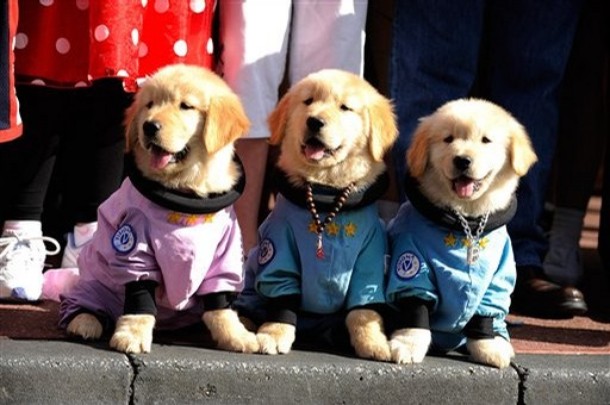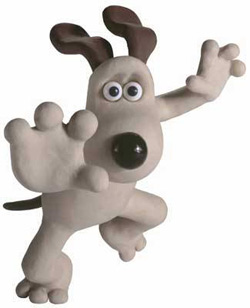It’s funny — and perhaps, in the contagious-episteme fashion of Elisha Gray and Alexander Graham Bell filing patents for the telephone on the very same date, a bit creepy — that Dan North of Spectacular Attractions should write on the topic of dog movies while I was preparing my own post about Space Buddies. This Disney film, which pornlike skipped theaters to go straight to DVD and Blu-Ray, is one of a spate of dog-centered films that have become a crowdpleasing filmic staple of late. Dan poses the question, “What is it about today that people need so many dog movies?” and goes on to speculate that we’re collectively drowning our sorrows at the world’s ugliness with a massive infusion of cute: puppyism as cultural anodyne.
Maybe so. It seems to me, though, that another dynamic is in operation here — and with all due respect to my follow scholar of visual effects, Dan may be letting the grumbly echoes of the Frankfurt School distract him from a fascinating nexus of technology, economics, and codes of expressive aesthetics driving the current crop of cinematic canines. Simply put, dogs make excellent cyberstars.
Think about it. Nowadays we’re used to high-profile turns by hybrids of human and digital performance: Angelina Jolie as Grendel’s goldplated mother in Beowulf, Brad Pitt as the wizened baby in The Curious Case of Benjamin Button. (Hmm, it only now strikes me that this intertextual madonna-and-child are married in real life; perhaps the nuclear family is giving way to the mo-capped one?) Such top-billed performances are based on elaborate rendering pipelines, to be sure, but their celebrity/notoriety is at least as much about the uniquely sexy and identifiable star personae attached to these magic mannequins: a higher order of compositing, a discursive special effect. It takes a ton of processing power to paint the sutured stars onto the screen, and an equivalent amount of marketing and promotion — those other, Foucauldian technologies — to situate them as a specific case of the more general Steady March Toward Viable Synthespianism. Which means, in terms of labor and capital, they’re bloody expensive. Mountains of data are moved in service of the smallest details of realism, and even then, nobody can get the eyes right.
But what of the humble cur and the scaled-down VFX needed to sell its blended performance? The five puppy stars of Space Buddies are real, indexically photographed dogs with digitally-retouched jaw movements and eyebrow expressions; child voice actors supply the final, intangible, irreplaceable proof of character and personality. (To hell with subsurface skin scatter and other appeals to our pathetically seducible eyes; the real threshold of completely virtual performance remains believable speech synthesis.) The canine cast of Beverly Hills Chihuahua, while built on similar principles, are ontologically closer to the army of Agent Smiths in The Matrix Reloaded’s burly brawl — U-Capped fur wrapped over 3D doll armatures and arrayed in Busby-Berkeleyish mass ornament. They are, in short, digital dogsbodies, and as we wring our hands over the resurrection of Fred Astaire in vacuum-cleaner ads and debate whether Ben Burtt’s sound design in Wall-E adds up to a best-actor Oscar, our screens are slowly filling with animals’ special-effects-driven stardom. How strange that we’re not treating them as the landmarks they are — despite their immense profitability, popularity, and paradoxical common-placeness. It’s like Invasion of the Body Snatchers, only cuddly!
I don’t mean to sound alarmist — though writing about the digital’s supposed incursion into the real always seems to bring out the edge in my voice. In truth, the whole thing seems rather wonderful to me, not just because I really dug Space Buddies, but because the dogsbody has been around a long time, selling audiences on the dramatic “realism” of talking animals. From Pluto to Astro, Scooby Doo to Rowlf, Lady and the Tramp to K-9, Dynomutt, and Gromit, dogs have always been animated beyond their biological station by technologies of the screen; we accept them as narrative players far more easily than we do more elaborate and singular constructions of the monstrous and exotic. The latest digital tools for imparting expression to dogs’ mouths and muzzles were developed, of all places, in pet-food ads: clumsy stepping stones that now look as dated as poor LBJ’s posthumous lipsynching in Forrest Gump.
These days it’s the rare dog (or cat, bear, and fish) onscreen whose face hasn’t been partially augmented with virtual prosthetics. Ultimately, this is less about technological capability than the legal and monetary bottom line: unlike human actors, animal actors can’t go ballistic on the lighting guy, or write cumbersome provisions into their contracts to copyright their “aura” in the age of mechanical reproduction. Our showbiz beasts exist near the bottom of the labor pool: just below that other mass of bodies slowly being fed into the meat-grinder of digitization, stuntpeople, and just above the nameless hoardes of Orcs jam-packing the horizon shots of Lord of the Rings. I think it was Jean Baudrillard, in The System of Objects, who observed that pets hold a unique status, poised perfectly between people and things. It’s a quality they happen to share with FX bodies, and for this reason I expect we’ll see menageries in the multiplex for years to come.



Who’s a good boy, then? You are. Yes you are. Yes you are. Nice post. It’s as if you translated my “WTF?” blog into a coherent argument.
You’re right. Dogs can’t unionise. You don’t need to pay them repeat fees or a cut of the grosses. They’ll work for scale and/or Mutt Mix. I said this on my own comments page, but I’m all for recycling, and it seems pertinent here: My problem with dog movies is that dogs are just terrible actors (with the notable and unfair exception of Gromit). Whenever they’re asked to portray any kind of emotional state (running the gamut from cute to worried via defensive or confused), I don’t see the performance – all I see is a dum labrador eyeing up the scooby snacks that are being dangled in front of them just out of shot. Either that, or you can tell that they’re desperate to stop reshooting that “hilarious” skateboard scene; in those cases, I always assume there’s some kind of cattle-prod or other instrument of coercion just off camera. Invariably, talking movie dogs are supposed to convey “sassy,” when all I can see in their eyes is “hungry.”
But I like your idea that dogs (and other animals) are intermediate test cases (hey, we experiment on them to test shampoos and airbags, so why not this?) for digital performance enhancement. “Man’s best friend”? More like “man’s cheapest proxy”. Puppetising animals has been Disney’s stock-in-trade for decades, and I can’t help wondering if it has cumulatively helped us to antropomorphise animals for real. You like to think you have an empathetic bond with your dog, when really you’re just the guy who knows how to work a tin opener. OK, that’s a bit cynical. Maybe I’m not qualified to comment on a bunch of movies I’m deliberately avoiding…
Arf!
Your thoughts on the unintentional pathos of dog acting make me think, weirdly, of pornography I’ve seen — not at all to equate human and dog bodies, but to point out how untenably fragile the illusion of “pleasure” can be when it’s all too clear that what’s happening on screen is less about some freely willed performance than the churning of a heartless industrial engine.
I was disturbed enough by this gap between preferred diegetic reality and inferred profilmic reality to ask my wife whether the dogs in Space Buddies struck her as being freaked out. She assured me the dogs would be panting if they were scared or tired … but it didn’t completely put my worries to rest.